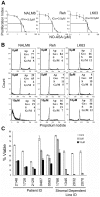Silencer of death domains controls cell death through tumour necrosis factor-receptor 1 and caspase-10 in acute lymphoblastic leukemia
- PMID: 25061812
- PMCID: PMC4111576
- DOI: 10.1371/journal.pone.0103383
Silencer of death domains controls cell death through tumour necrosis factor-receptor 1 and caspase-10 in acute lymphoblastic leukemia
Abstract
Resistance to apoptosis remains a significant problem in drug resistance and treatment failure in malignant disease. NO-aspirin is a novel drug that has efficacy against a number of solid tumours, and can inhibit Wnt signaling, and although we have shown Wnt signaling to be important for acute lymphoblastic leukemia (ALL) cell proliferation and survival inhibition of Wnt signaling does not appear to be involved in the induction of ALL cell death. Treatment of B lineage ALL cell lines and patient ALL cells with NO-aspirin induced rapid apoptotic cell death mediated via the extrinsic death pathway. Apoptosis was dependent on caspase-10 in association with the formation of the death-inducing signaling complex (DISC) incorporating pro-caspase-10 and tumor necrosis factor receptor 1 (TNF-R1). There was no measurable increase in TNF-R1 or TNF-α in response to NO-aspirin, suggesting that the process was ligand-independent. Consistent with this, expression of silencer of death domain (SODD) was reduced following NO-aspirin exposure and lentiviral mediated shRNA knockdown of SODD suppressed expansion of transduced cells confirming the importance of SODD for ALL cell survival. Considering that SODD and caspase-10 are frequently over-expressed in ALL, interfering with these proteins may provide a new strategy for the treatment of this and potentially other cancers.
Conflict of interest statement
Figures







Similar articles
-
[Effects of SODD and survivin on leukemia cell apoptosis induced by chemotherapeutic drugs].Zhongguo Shi Yan Xue Ye Xue Za Zhi. 2007 Jun;15(3):501-5. Zhongguo Shi Yan Xue Ye Xue Za Zhi. 2007. PMID: 17605853 Chinese.
-
Significance of SODD expression in childhood acute lymphoblastic leukemia and its influence on chemotherapy.Genet Mol Res. 2014 Mar 24;13(1):2020-31. doi: 10.4238/2014.March.24.6. Genet Mol Res. 2014. PMID: 24737427
-
TNF-related apoptosis-inducing ligand (TRAIL) frequently induces apoptosis in Philadelphia chromosome-positive leukemia cells.Blood. 2003 May 1;101(9):3658-67. doi: 10.1182/blood-2002-06-1770. Epub 2002 Dec 27. Blood. 2003. PMID: 12506034
-
Biochemical analysis of the native TRAIL death-inducing signaling complex.Methods Mol Biol. 2008;414:221-39. doi: 10.1007/978-1-59745-339-4_16. Methods Mol Biol. 2008. PMID: 18175822 Review.
-
Playing the DISC: turning on TRAIL death receptor-mediated apoptosis in cancer.Biochim Biophys Acta. 2010 Apr;1805(2):123-40. doi: 10.1016/j.bbcan.2009.11.004. Epub 2009 Dec 2. Biochim Biophys Acta. 2010. PMID: 19961901 Review.
Cited by
-
A New Histology-Based Prognostic Index for Acute Myeloid Leukemia: Preliminary Results for the "AML Urayasu Classification".J Clin Med. 2025 Mar 15;14(6):1989. doi: 10.3390/jcm14061989. J Clin Med. 2025. PMID: 40142797 Free PMC article.
-
Annexin A7 and Its Related Protein Suppressor of Death Domains Regulates Migration and Proliferation of Hca-P Cells.Cell J. 2023 Nov 1;25(11):801-808. doi: 10.22074/cellj.2023.559724.1108. Cell J. 2023. PMID: 38071412 Free PMC article.
-
The PI3K/mTOR dual inhibitor BEZ235 suppresses proliferation and migration and reverses multidrug resistance in acute myeloid leukemia.Acta Pharmacol Sin. 2017 Mar;38(3):382-391. doi: 10.1038/aps.2016.121. Epub 2017 Jan 2. Acta Pharmacol Sin. 2017. PMID: 28042875 Free PMC article.
-
Defined factors to reactivate cell cycle activity in adult mouse cardiomyocytes.Sci Rep. 2019 Dec 11;9(1):18830. doi: 10.1038/s41598-019-55027-8. Sci Rep. 2019. PMID: 31827131 Free PMC article.
-
Matteucinol combined with temozolomide inhibits glioblastoma proliferation, invasion, and progression: an in vitro, in silico, and in vivo study.Braz J Med Biol Res. 2022 Aug 22;55:e12076. doi: 10.1590/1414-431X2022e12076. eCollection 2022. Braz J Med Biol Res. 2022. PMID: 36000612 Free PMC article.
References
-
- Pui CH (2010) Recent research advances in childhood acute lymphoblastic leukemia. J Formos Med Assoc 109: 777–787. - PubMed
-
- Gokbuget N, Hoelzer D (2009) Treatment of adult acute lymphoblastic leukemia. Semin Hematol 46: 64–75. - PubMed
-
- Movassagh M, Foo R (2008) Simplified apoptotic cascades. Heart Fail Rev 13: 111–119. - PubMed
-
- Goldstein J, Waterhouse N, Juin P, Evan G, Green D (2000) The coordinate release of cytochrome c during apoptosis is rapid, complete and kinetically invariant. Nat Cell Biol 2(3):156–62 2(3): 156–162. - PubMed
-
- Li P, Nijhawan D, Budihardjo I, Srinivasula SM, Ahmad M, et al. (1997) Cytochrome c and dATP-dependent formation of Apaf-1/caspase-9 complex initiates an apoptotic protease cascade. Cell 91: 479–489. - PubMed
Publication types
MeSH terms
Substances
LinkOut - more resources
Full Text Sources
Other Literature Sources

